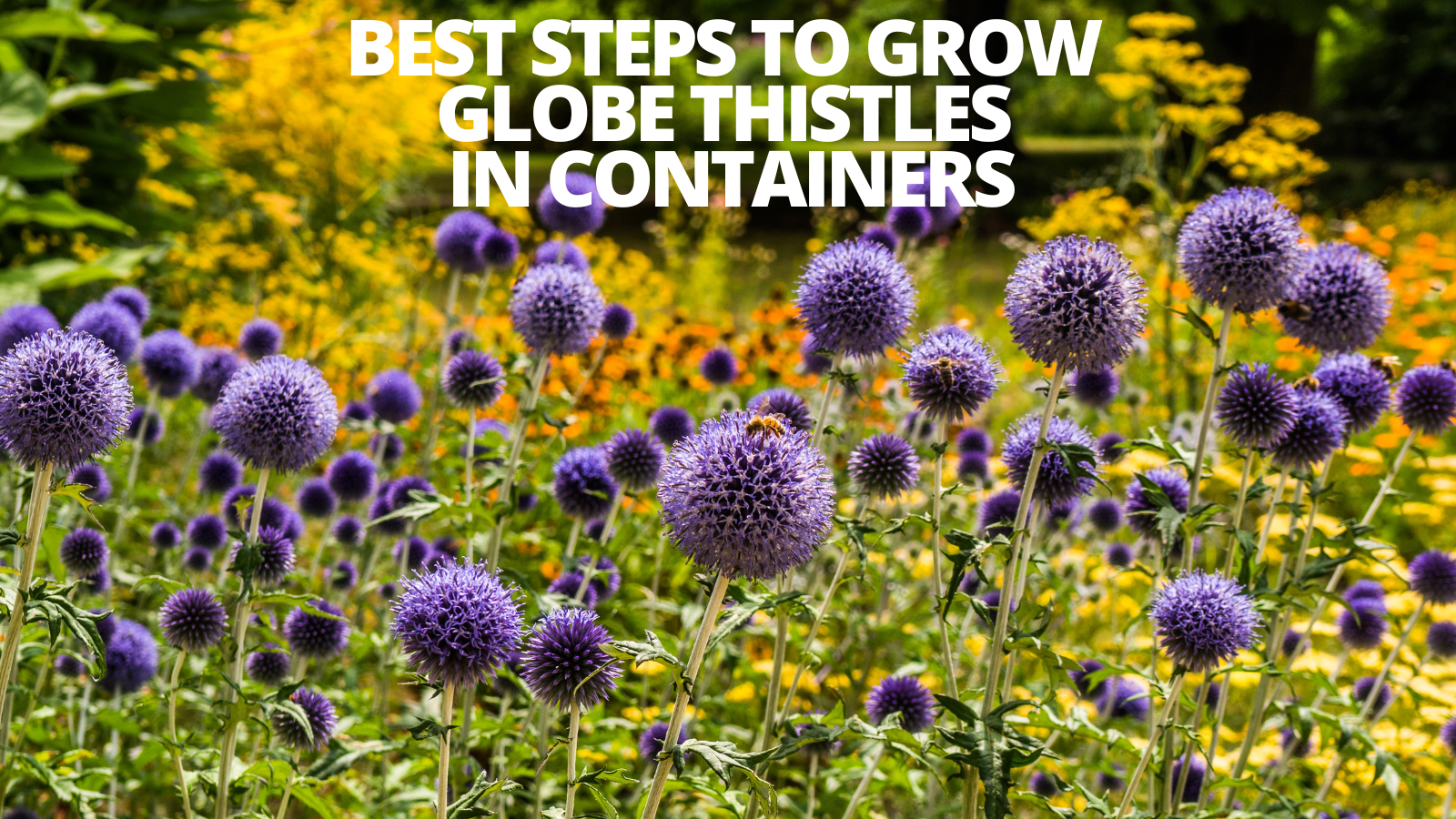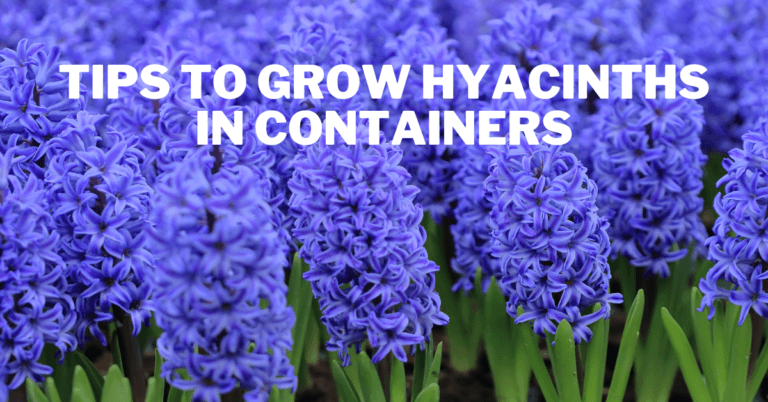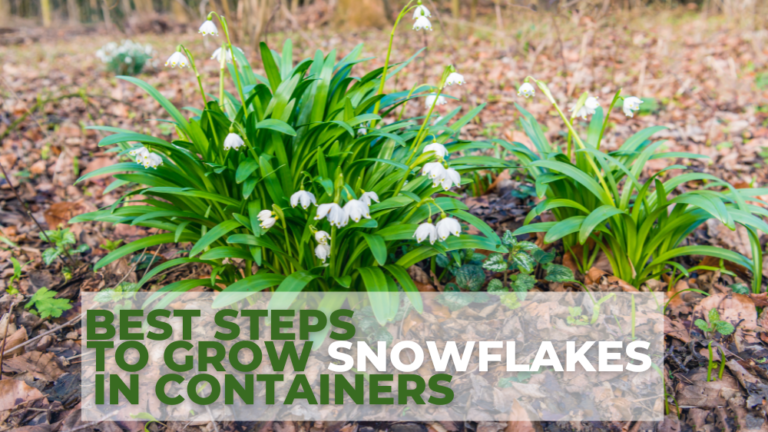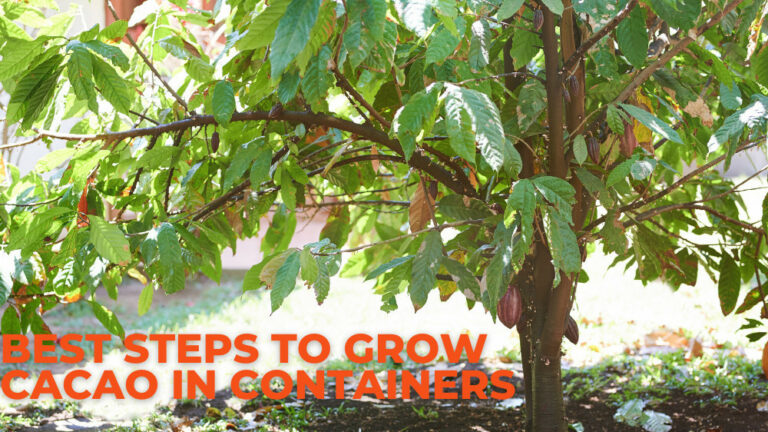Best Steps To Grow Globe Thistles In Containers
Best Steps To Grow Globe Thistles In Containers
The Globe thistle is a modern-looking flower with old-world characteristics that proliferates. Its spherical blue blooms give summer border gardens a striking flash of colour.
In contrast to other striking perennials, Globe thistle is drought tolerant and deer resistant and a vital source of honey for bees and butterflies.
The globe thistle's spiky, spiny leaf plays a crucial role in the garden as a host for the picky-painted lady butterfly.
Globe thistles should be planted in May or June for midsummer blooms that linger into the fall.
The globe thistle then continues adding textural interest with its gorgeous seed heads after blooming.
History & Origin Of Globe Thistles
The globe thistle has a long history of being a well-liked plant, though usually not for its aesthetic appeal.
The anti-inflammatory and lactation-promoting properties of the roots were primarily employed by herbalists to treat mastitis and breast swelling.
In the 1700s, famed Swedish botanist Charles Linnaeus gave the globe thistle its first name.
Echinops, a Greek word loosely translated to “hedgehog head,” is how he correctly called the genus.
Over 120 distinct globe thistles make up the sizable genus Echinops. The most well-known of these is Echinops ritro, one of the few that found their way into backyard gardens.
The southern globe thistle, Echinops ritro, is a species of flowering plant in the family Asteraceae indigenous to western Asia and southern and eastern Europe (from Spain east to Turkey, Ukraine, and Belarus).
Only a few isolated Canadian and American locales have naturally allowed the species to occur.
Echinops ritro is a small, bushy, perennial thistle that can reach a height of 60 cm (24 in), has thick, thorny leaves, and blooms in the late summer with globes of steel-blue flowers that range in size from 2.5 cm to 4.5 cm.
The Royal Horticultural Society awarded Echinops ritro and the subspecies E. ritro subsp. ruthenicus its Award of Garden Merit.
Types Of Globe Thistles
Ideally, you should know the best varieties before you grow globe thistles in containers.
1. Southern Globe Thistles
The southern globe thistle, or Echinops ritro, is a species of flowering plant in the Asteraceae family that is indigenous to southern and eastern Europe and western Asia.
2. Echinops Bannaticus Globe Thistles
Southeast Europe is home to the flowering plant species Echinops bannaticus, also referred to as the blue globe thistle.
It is a 120 cm tall herbaceous perennial thistle with prickly foliage and spherical blue summer flower heads.
3. Echinops Setifer Globe Thistles
Echinops setifer, also known as higotai or Echinops setifer, is a perennial grass indigenous to China, the Korean Peninsula, and Japan.
Its scientific name is Echinops setifer. The leaves resemble thistle leaves, thin and pinnately lobed (jagged).
4. Echinops Spinosissimus Globe Thistles
A kind of European plant called Echinops spinosissimus belongs to the Cardueae tribe of the Asteraceae family.
It is indigenous to southwest Asia, Iran, northern Africa, and southeastern Europe. The perennial herb Echinops spinosissimus has branches and grows up to 80 cm tall.
5. Echinops Exaltatus Globe Thistles
The European globe thistle in the Asteraceae family is called Echinops exaltatus, sometimes known as the tall or Russian globe thistle. It is indigenous to central and eastern Europe, from Russia eastward to Germany and Italy.
Grow Globe Thistles In Containers
Look no farther than the globe thistle for a stunningly distinctive blue flower that adds some variation to your yard.
Depending on your hardiness zone, this unusual plant is easy to care for and has stunningly lovely blue blossoms.
In this article, a gardening expert, Madison Moulton, explains how to cultivate, care for, and plant this remarkable plant.
Choose The Right Container
The globe thistle's large taproot makes potting difficult. For this reason, select a sizable clay or terracotta pot with good drainage as the location of your plant's permanent home.
Use cactus potting soil or sandy loam, and only re-pot your thistle when it has to be divided because it is outgrowing its container.
Location To Grow Globe Thistles In Containers
Echinop plants are pretty robust. They can withstand dryness and the summer heat, even in sites with direct sunlight.
In loose, somewhat humus-rich, and dry soil, Echinops grow straight and robustly quite well. The globe thistle is prone to tipping over in overly wet or nutrient-rich areas.
Echinops plants are a fantastic eye-catcher in prairie and alpine gardens and go well with other drought-tolerant plants like yarrow (Achillea millefolium), Gypsophila, or other grasses.
There is no chance of slugs eating globe thistles because they are frequently not the preferred diet for bugs.
Soil Grow Globe Thistles In Containers
The globe thistles' health depends on good drainage. This plant prefers dry, rocky, or loamy soil with an acidic pH of 5.5 to 7.
Try growing globe thistle in raised beds with modified soil to help with drainage if your landscape is mostly clay. You could also grow this flower in containers.
Planting
Globe thistles are easy to plant. Plant the seedlings in the spring as the weather starts to warm up.
There should be no imminent frost to avoid transplant shock and give your new plants a solid start.
Loosen the soil and remove weeds and trash before planting in the selected location. Next, make a hole somewhat more extensive and more profound than it is anticipated to be.
If the roots of this plant are allowed enough room to expand, it will thrive. Additionally, mature plants have a spread of roughly 2 feet and a maximum height of 4 feet.
If you plant many plants, give them room to grow and spread. Each transplant needs to be at least two feet apart.
Your bed may appear empty, but it will quickly fill up. Root cuttings of the blue globe thistle can be easily planted in a preferred, sunny position and will flourish there.
Similar to this, a plant that has been divided will grow back just as well if planted again at the same depth.
Watering should be done gently and thoroughly on all new plantings. This technique enables water to reach deeper soil layers. Until the plants are established, keep the soil well-watered.
Planting In Pots
The blue globe thistle often appears at home in cottage gardens' flower beds. However, they are also as striking in pots, making them ideal for patios and small spaces.
It is a simple method for limiting these plants' spread and fast growth. These plants will thrive in a pot with good drainage large enough to fit their long taproots.
This plant needs a soil mixture, like cactus potting soil, that drains effectively.
Unfortunately, garden soil is unsuitable for container plants because it frequently becomes compacted and lacks the required drainage.
Although this attractive perennial is known for being low-maintenance, it needs extra care, such as additional watering, when planted in containers.
Sunlight Requirements
To stay compact and bloom properly, the globe thistles require a full day of sunlight (at least six hours).
Plant it on the south or west side of the house if it will be a foundation border. This plant can withstand a little morning or afternoon shade, but if the conditions continue, it will become leggy.
Watering Requirements
The globe thistles can withstand even the most severe droughts thanks to its lengthy taproot.
During the first month after planting, water newly planted globe thistles once a week to aid the plant's establishment.
The thistles should only be watered if they exhibit drought stress symptoms, such as wilting and brown leaves.
Temperature & Humidity
The best-growing range for globe thistle plants is 65 to 75°F, although this plant can withstand higher temperatures found in USDA zones 9 and 10.
Globe thistle plants flourish in warm, dry climates. Provide adequate plant spacing for ventilation and place the plant in full sun in humid locations to dry the soil and prevent mildew.
Propagation
Start with seeds or root cuttings to cultivate this plant. Additionally, the division is feasible but difficult.
From Seeds
Following your region's last typical frost date, sow seeds in the spring. Work the dirt to a depth of about 12 inches until it has a crumbly consistency.
Sprinkle a few seeds every 24 to 30 inches into moist soil. You can thin the seedlings to one robust plant per interval after they have two pairs of genuine leaves.
Alternatively, sow seeds inside four to six weeks before the last frost date. To reduce root disruption, use biodegradable seed starting cells that can be transplanted whole.
Per seed starter cell, plant two to three seeds. Thin the seedlings to one per cell once they have two sets of genuine leaves.
Acclimate the seedlings to the outdoors for a few hours each day after the threat of frost has passed.
If you use starter cells that disintegrate, leave the seedlings there. They should be 24 to 30 inches apart.
So that the potting media in the cell is level with the ground, place them in the garden soil and lightly cover them.
From Root Cuttings
During late winter or early spring dormancy, you can also start plants by taking cuttings from the lateral roots of an established plant.
To uncover roots that emerge laterally from the middle of a plant clump, carefully dig four to six inches away from the plant.
Pick a root and gently remove the soil above and below it to reveal it. Cut a length of four to five inches from the area of the root that is the thickest.
After making your cut, tamp the earth back down over the rootstock of the main plant.
Bury the root piece horizontally and about three inches deep in garden soil or container potting medium in a spot where they can receive full sunlight.
Dip the cut ends of the root piece into rooting hormone powder. Water the area and keep it evenly damp until it takes. Green growth is a sign of achievement.
By Division
An existing plant may also be divided in the spring or fall. This is difficult because E. ritro has a long, dense taproot that is difficult to estimate in length.
Lift the entire plant out of the ground by digging it up and gradually loosening the soil around it. Examine the roots after removing the dirt.
A taproot and fibrous side roots should be visible. Cut the taproot in half so each piece has some taproot and one or more “eyes,” or the spots where the fibrous roots sprout.
Divide the plants again to the same depth. The portion of the taproot that is left in the ground, if you accidentally cut it during the unearthing, will probably regrow.
However, it's possible that divisions don't have enough root stock linked to them to grow well.
Fertilizer
Echinops plants don't need a lot of nutrients in their soil. However, the globe thistle can also experience nutritional deficits in extremely nutrient-poor soils or rock gardens, frequently showing leaf discolouration, slow development, and diminished flowering.
Adding fertilizer can support struggling Echinops plants. The best time to fertilize perennials in spring.
We advise applying slow-release, natural fertilizers like Plantura All Purpose Plant Food. Soil organisms break down these nutrients gradually throughout the season.
Pruning And Maintenance
The small globe thistle is pretty and easy to care for. To promote a second bloom, deadhead spent blooms during the growing season by pruning stems slightly above a pair of leaves; in the event of a protracted dry spell, water.
If necessary, stake tall plants to keep them from bending and shattering. Broken stems are not only unsightly, but they are also susceptible to disease and pests.
Regular weeding will reduce competition for water, maintain ideal airflow, keep pests at bay, and stop fungal growth.
Remove all flower heads as they fade before they turn brown, and set seeds to prevent self-sowing.
To prevent pests and pathogens from overwintering, cut all stems to the ground in the fall after the first frost and remove the debris.
You can let self-sown seedlings develop in the spring or pull them out. You could attempt to transfer them, but remember that the taproot is delicate.
Pests & Diseases Of Globe Thistles
Although globe thistles don't suffer from the same number of pests and diseases as plants from other families do, they do have some to which they are vulnerable.
Let's examine what to anticipate when defending against a pest infestation or any diseases that can attempt to infect your plants.
Pests
Fortunately, deer and rabbits don't often bother globe thistles and are also resistant to pests.
Their eye-catching blue globes draw pollinators, especially butterflies, who like munching on the spiky flowers.
Unfortunately, some pests, such as aphids, the four-lined plant insect, and Echinops leaf minor, adore these plants just as much as butterflies.
Aphids, a shared garden pest, will hide behind the leaves of most flowering plants, including globe thistles.
If ignored, an aphid infestation can soon spiral out of control. Fortunately, controlling and preventing an aphid infestation is simple.
Aphids are simple to notice if you add inspecting the undersides of leaves to your daily gardening practice. Squish an aphid or two (or any other bug) between your fingers if you see them.
Neem oil horticulture sprays can be used to control larger aphid colonies. Neem oil is an excellent natural pesticide, but remember that it can scare off pollinators. Aphid predators like ladybugs can also be added to your garden to prey on aphids.
Natural predators and horticultural sprays are the primary lines of defence against Echinops leaf miners.
A tiny black wasp called Diglyphus isaea, also known as the leaf minor parasite, devours leaf miners. There are various nurseries where you may get them.
The four-lined plant insect causes largely cosmetic harm, making it a less concerning pest.
However, removing insects from the leaves may easily prevent the beauty of your globe thistles from being ruined.
Sprays for gardens might also assist get rid of this bothersome bug. Fortunately, these bugs have a relatively brief lifespan, so there is minimal risk of an extensive infestation.
Diseases
Powdery mildew rarely impacts this plant, yet it can seriously harm your plants. On plant foliage, this fungus induces the growth of a powdery, white mould.
It can swiftly spread, causing wilting and dropping of the leaves as well as, in extreme circumstances, the death of the plant.
Given that the base of the plant stem often turns yellow, root rot signs are simple to identify. Additionally, the eye-catching silvery foliage could start to wilt and wither.
Fortunately, powdery mildew and root rot are also easily avoidable. Maintain the proper plant spacing to allow enough air to pass through the foliage. Airflow is also enhanced by pruning.
Another simple precaution is to maintain appropriate garden hygiene. Use only clean gardening tools and clear away any rubbish around the base of your plants. Overwatering and overhead irrigation should both be avoided.
Conclusion
The most notable features of thistles are their prickly leaves that encircle their blooms and exquisite blooms, which come in various colours from dark pink to vivid lavender. Thistles come in a wide variety, including the globe, milk, and Scots thistle.
They are resilient wildflowers in the daisy family that, when appropriately dried, keep both their colour and shape.
You can enjoy the flowers year-round by gathering them and drying them in the middle of the summer, just before they bloom.
I trust you enjoyed this article on the Best Steps To Grow Globe Thistles In Containers. Please stay tuned for more blog posts to come shortly. Take care!
JeannetteZ
>>>Please click here to read my all-inclusive article about Container Gardening<<<
>>>Are you interested in homegrown herbs and medicine? Please click here to find out more about it!<<<
Your Opinion Is Important To Me
Thoughts? Ideas? Questions? I would love to hear from you. Please leave me your questions, experience, and remarks about this article on the Best Steps To Grow Globe Thistles In Containers in the comments section below. You can also reach me by email at Jeannette@Close-To-Nature.org.
Disclosure
This post may contain affiliate links. As an Amazon Associate and other affiliate programs, I earn from qualifying purchases at no extra cost to you. Read my full affiliate disclosure.
You might also enjoy these blog posts:
Best Steps To Grow Saffron In Containers
Best Steps To Grow Love-Lies-Bleeding In Containers
Best Steps To Grow Cacao In Containers
Best Steps To Grow Squash In Containers
Best Steps To Grow Camelia In Containers























